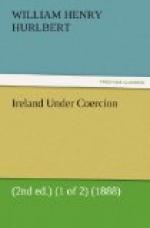I dined to-night at the Castle, not in the great hall or banqueting-room of St. Patrick, which was designed by that connoisseur in magnificence, the famous Lord Chesterfield, during his Viceroyalty, but in a very handsome room of more moderate dimensions. Much of the semi-regal state observed at the Castle in the days of the Georges has been put down with the Battle-Axe Guards of the Lord-Lieutenant, and with the basset-tables of the “Lady-Lieutenant,” as the Vice-queen used to be called. At dinner the Viceroy no longer drinks to the pious and immortal memory of William III., or to the “1st of July 1690.” No more does the band play “Lillibullero,” and no longer is the pleasant custom maintained, after a dinner to the city authorities of Dublin, of a “loving cup” passed around the table, into which each guest, as it passed, dropped a gold piece for the good of the household. Only so much ceremonial is now observed as suffices to distinguish the residence of the Queen’s personal representative from that of a great officer of State, or an opulent subject of high rank.
Dublin Castle indeed is no more of a palace than it is of a castle. Its claim to the latter title rests mainly on the fine old “Bermingham” tower of the time of King John; its claim to the former on the Throne Room, the Council Chamber, and the Hall of St. Patrick already mentioned. This last is a very stately and sumptuous apartment. Just twenty years ago the most brilliant banquet modern Dublin has seen was given in this hall by the late Duke of Abercorn to the Prince and Princess of Wales, to celebrate the installation of the Prince as a Knight of St. Patrick. It is a significant fact, testified to by all the most candid Irishmen I have ever known, that upon the occasion of this visit to Ireland in 1868 the Prince and Princess were received with unbounded enthusiasm by the people of all classes. Yet only the year before, in 1867, the explosion of some gunpowder at Clerkenwell by a band of desperadoes, to the death and wounding of many innocent people, had brought the question of the disestablishment of the Irish Church, in the mind of Mr. Gladstone, within the domain of “practical politics”! By parity of reasoning, one would think, the reception of the heir-apparent and his wife in Ireland ought to have taken that question out of the domain of “practical politics.”
The Prince of Wales, it is known, brought away from this visit an impression that the establishment of a prince of the blood in Ireland, or a series of royal visits to Ireland, would go far towards pacifying the relations between the two Islands. Mr. Gladstone thought his Disestablishment would quite do the work. Events have shown that Mr. Gladstone made a sad mistake as to the effect of his measure. The pains which, I am told, were taken by Mr. Deasy, M.P., and others to organise hostile demonstrations at one or two points in the south of Ireland, during a subsequent visit of the Prince and Princess, would seem to show that in the opinion of the Nationalists themselves, the impression of the Prince was more accurate than were the inferences of the Premier.




